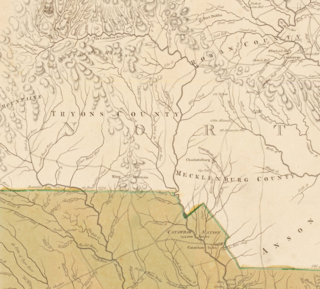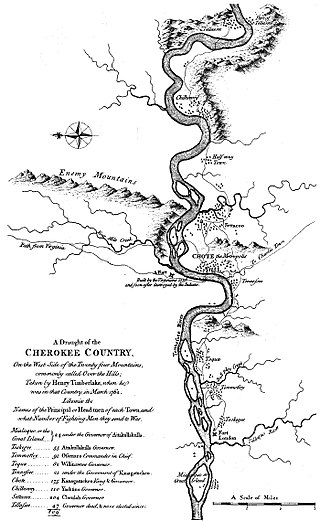
The Tuscarora are an Indigenous people of the Northeastern Woodlands in Canada and the United States. They are an Iroquoian Native American and First Nations people, based in New York and Ontario.

The French and Indian War (1754–1763) was a theater of the Seven Years' War, which pitted the North American colonies of the British Empire against those of the French, each side being supported by various Native American tribes. At the start of the war, the French colonies had a population of roughly 60,000 settlers, compared with 2 million in the British colonies. The outnumbered French particularly depended on their native allies.

Queen Anne's War (1702–1713) was the second in a series of French and Indian Wars fought in North America involving the colonial empires of Great Britain, France, and Spain; it took place during the reign of Anne, Queen of Great Britain. In the United States, it is regarded as a standalone conflict under this name. Elsewhere it is usually viewed as the American theater of the War of the Spanish Succession. It is also known as the Third Indian War. In France it was known as the Second Intercolonial War.

The term Five Civilized Tribes was applied by the United States government in the early federal period of the history of the United States to the five major Native American nations in the Southeast: the Cherokee, Chickasaw, Choctaw, Muscogee (Creek), and Seminoles. White Americans classified them as "civilized" because they had adopted attributes of the Anglo-American culture.

The Lenape, also called the Lenni Lenape and Delaware people, are an Indigenous people of the Northeastern Woodlands, who live in the United States and Canada.

The Catawba, also known as Issa, Essa or Iswä but most commonly Iswa, are a federally recognized tribe of Native Americans, known as the Catawba Indian Nation. Their current lands are in South Carolina, on the Catawba River, near the city of Rock Hill. Their territory once extended into North Carolina, as well, and they still have legal claim to some parcels of land in that state. They were once considered one of the most powerful Southeastern tribes in the Carolina Piedmont, as well as one of the most powerful tribes in the South as a whole, with other, smaller tribes merging into the Catawba as their post-contact numbers dwindled due to the effects of colonization on the region.

The Anglo-Cherokee War, was also known from the Anglo-European perspective as the Cherokee War, the Cherokee Uprising, or the Cherokee Rebellion. The war was a conflict between British forces in North America and Cherokee bands during the French and Indian War.
The Yamasee War was a conflict fought in South Carolina from 1715 to 1717 between British settlers from the Province of Carolina and the Yamasee, who were supported by a number of allied Native American peoples, including the Muscogee, Cherokee, Catawba, Apalachee, Apalachicola, Yuchi, Savannah River Shawnee, Congaree, Waxhaw, Pee Dee, Cape Fear, Cheraw, and others. Some of the Native American groups played a minor role, while others launched attacks throughout South Carolina in an attempt to destroy the colony.

Waccamaw Siouan Indians are one of eight state-recognized tribes in North Carolina. Also known as the Waccamaw Siouan Indian Tribe, they are not federally recognized. They are headquartered in Bolton, in Columbus County, and also have members in Bladen County in southeastern North Carolina.

The Cheraw people, also known as the Saraw or Saura, were a Siouan-speaking tribe of Indigenous people of the Southeastern Woodlands, in the Piedmont area of North Carolina near the Sauratown Mountains, east of Pilot Mountain and north of the Yadkin River. They lived in villages near the Catawba River. Their first European and African contact was with the Hernando De Soto Expedition in 1540. The early explorer John Lawson included them in the larger eastern-Siouan confederacy, which he called "the Esaw Nation."
Andrew Montour, also known as Sattelihu, Eghnisara, and Henry, was an important mixed interpreter and negotiator in the Virginia and Pennsylvania backcountry in the latter half of the 18th century. He was of Oneida and Algonquin ancestry, with a French grandfather. Historian James Merrell estimated his birth year as 1720. Likely born in his mother's village of Otstonwakin, he later led the village in the 18th century before settling further west.
The Wateree were a Native American tribe in the interior of the present-day Carolinas. They probably belonged to the Siouan-Catawba language family. First encountered by the Spanish in 1567 in Western North Carolina, they migrated to the southeast and what developed as South Carolina by 1700, where English colonists noted them.
The Congaree were a historic Indigenous people of the Southeastern Woodlands who once lived within what is now central South Carolina, along the Congaree River.

King Hagler or Nopkehee was a chief of the Catawba Native American tribe from 1754 to 1763. Hagler is known as the "Patron Saint of Camden, South Carolina." He was the first Native American to be inducted into the South Carolina Hall of Fame. He is known for opposing the sale of alcohol to Catawbas and other Native Americans, and encouraged the Catawba people to abstain from alcohol. He worked to negotiate fair land rights and treaties for the Catawba people.
Daniel Karl Richter is an American historian specializing in early American history, especially colonial North America and Native American history before 1800. He is the Roy F. and Jeannette P. Nichols Professor of American History at the University of Pennsylvania and the Richard S. Dunn Director of the McNeil Center for Early American Studies. His book Facing East from Indian Country was a finalist for the Pulitzer Prize in 2002.
Alan Gallay is an American historian. He specializes in the Atlantic World and Early American history, including issues of slavery. He won the Bancroft Prize in 2003 for his The Indian Slave Trade: the Rise of the English Empire in the American South, 1670-1717.

The Battle of Echoee, or Etchoe Pass, was a battle on June 27, 1760 during the French and Indian War, between the British and colonial force under Archibald Montgomerie and a force of Cherokee warriors under Seroweh. It took place near the present-day municipality of Otto, in Macon County, North Carolina.

Fort Dobbs was an 18th-century fort in the Yadkin–Pee Dee River Basin region of the Province of North Carolina, near what is now Statesville in Iredell County. Used for frontier defense during and after the French and Indian War, the fort was built to protect the American settlers of the western frontier of North Carolina, and served as a vital outpost for soldiers. Fort Dobbs' primary structure was a blockhouse with log walls, surrounded by a shallow ditch, and by 1759, a palisade. It was intended to provide protection from French-allied Native Americans such as the Shawnee raids into western North Carolina.
The Sewee or "Islanders" were a Native American tribe that lived in present-day South Carolina in North America.

The Keyauwee Indians were a small North Carolina tribe, native to the area of present day Randolph County, North Carolina. The Keyauwee village was surrounded by palisades and cornfields about thirty miles northeast of the Yadkin River, near present day High Point, North Carolina. The Keyauwee village was vulnerable to attack, so the Keyauwee constantly joined with other tribes for better protection. They joined with the Tutelo, Saponi, Occaneechi, and the Shakori tribes, moving to the Albemarle Sound with the last two for a settlement that would later be foiled. The Keyauwee would move further southward along with the Cheraw and Peedee tribes, close along the border of the two Carolinas, where they conducted deerskin trade with Charleston traders and allied with the Indian neighbors in the Yamassee War. Eventually, their tribe name vanished from historical records, and with time, they were absorbed by the Catawba tribe.












